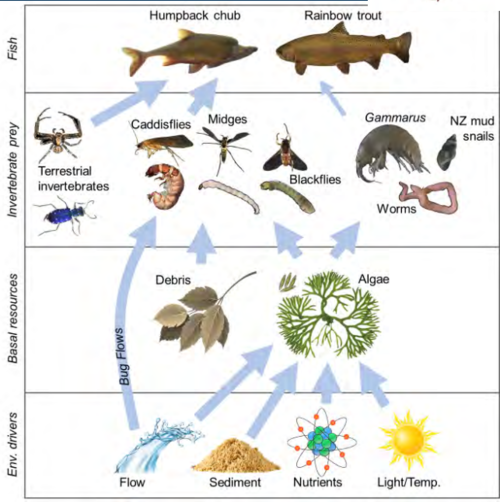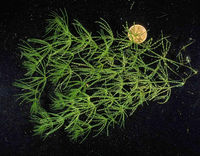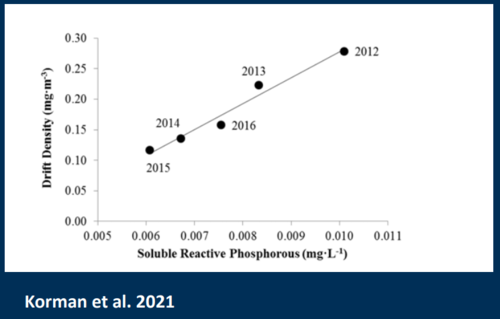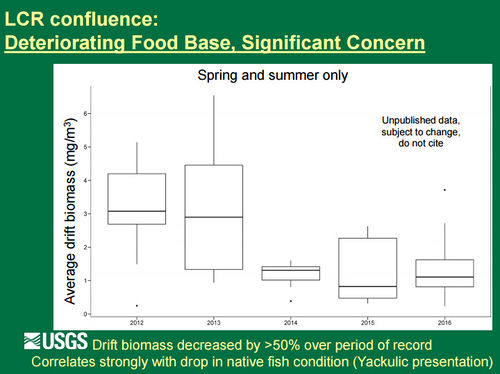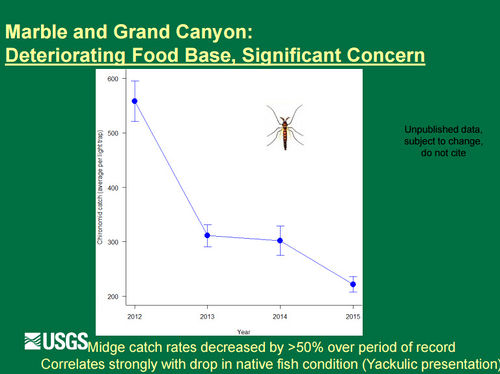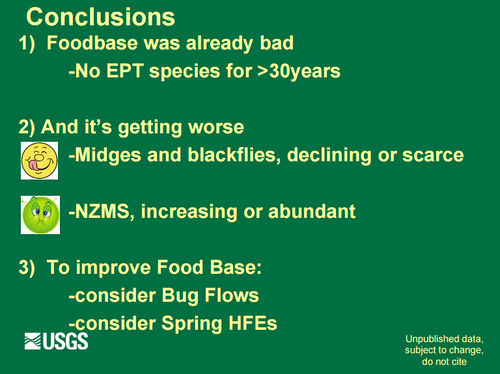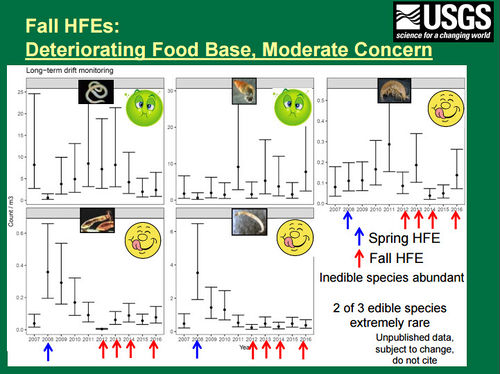Difference between revisions of "FOOD BASE"
Cellsworth (Talk | contribs) |
Cellsworth (Talk | contribs) |
||
| (11 intermediate revisions by the same user not shown) | |||
| Line 17: | Line 17: | ||
</table> | </table> | ||
| − | [[File: | + | [[File:FoodbaseModel.PNG|thumb|center|500px| https://www.usbr.gov/uc/progact/amp/twg/2022-01-13-twg-meeting/20220113-AnnualReportingMeeting-ProjectF-AquaticEcologyFoodBaseMonitoring-508-UCRO.pdf ]] |
<!-- | <!-- | ||
| Line 49: | Line 49: | ||
|style="color:#000;"| | |style="color:#000;"| | ||
| + | [[File:NutrientsDrift.PNG|thumb|center|500px|Variable phosphorus release from Glen Canyon Dam controls tailwater food webs https://www.usbr.gov/uc/progact/amp/twg/2022-01-13-twg-meeting/20220113-AnnualReportingMeeting-pHRegulatesPhosphorusCyclingColoradoRiver-508-UCRO.pdf ]] | ||
[[File:2017AR LCRbiomass.jpg|thumb|center|500px| https://www.usbr.gov/uc/rm/amp/twg/mtgs/17jan26/AR19_Kennedy.pdf ]] | [[File:2017AR LCRbiomass.jpg|thumb|center|500px| https://www.usbr.gov/uc/rm/amp/twg/mtgs/17jan26/AR19_Kennedy.pdf ]] | ||
[[File:2017AR MidgeAbundance.jpg|thumb|center|500px| https://www.usbr.gov/uc/rm/amp/twg/mtgs/17jan26/AR19_Kennedy.pdf ]] | [[File:2017AR MidgeAbundance.jpg|thumb|center|500px| https://www.usbr.gov/uc/rm/amp/twg/mtgs/17jan26/AR19_Kennedy.pdf ]] | ||
| Line 113: | Line 114: | ||
|- | |- | ||
|style="color:#000;"| | |style="color:#000;"| | ||
| + | |||
| + | '''2023''' | ||
| + | *[https://doi.org/10.1139/cjfas-2022-0229 Hansen et al., 2023, Linking ecosystem processes to consumer growth rates—Gross primary productivity as a driver of freshwater fish somatic growth in a resource-limited river: Canadian Journal of Fisheries and Aquatic Sciences] | ||
| + | *[https://doi.org/10.1002/jwmg.22414 Metcalfe et al., 2023, Insectivorous bat foraging tracks the availability of aquatic flies (Diptera), The Journal of Wildlife Management] | ||
| + | *[https://doi.org/10.1002/tafs.10381 Yard et al., 2023, Declines in prey production during the collapse of a tailwater rainbow trout population are associated with changing reservoir conditions: Transactions of the American Fisheries Society] | ||
| + | *[https://www.usbr.gov/uc/progact/amp/twg/2023-01-26-twg-meeting/20230126-AnnualReportingMeeting-MolecularModelingToolsTrackingFoodBaseDynamicsChangingEnvironments-508-UCRO.pdf Molecular and modeling tools for tracking food base dynamics in changing environments] | ||
| + | *[[Media:BAO_Approved-LHansen-Rev_Poster.pdf| A Decade of GPP Data in a Changing River]] | ||
| + | *[[Media:Wehr-Wrey-Stevens_diatoms.pdf| Changes in epiphytic diatoms in the Colorado River downstream of Glen Canyon Dam following reduced flow variation]] | ||
'''2022''' | '''2022''' | ||
| + | *[https://www.usbr.gov/uc/progact/amp/amwg/2022-02-10-amwg-meeting/20220210-ProjectF-AquaticEcologyFoodBaseMonitoring-508-UCRO.pdf Project F: Aquatic ecology and food base monitoring ] | ||
*[https://www.usbr.gov/uc/progact/amp/twg/2022-01-13-twg-meeting/20220113-AnnualReportingMeeting-ProjectF-AquaticEcologyFoodBaseMonitoring-508-UCRO.pdf Project F: Aquatic ecology and food base monitoring ] | *[https://www.usbr.gov/uc/progact/amp/twg/2022-01-13-twg-meeting/20220113-AnnualReportingMeeting-ProjectF-AquaticEcologyFoodBaseMonitoring-508-UCRO.pdf Project F: Aquatic ecology and food base monitoring ] | ||
| Line 124: | Line 134: | ||
'''2020''' | '''2020''' | ||
| + | *[https://www.sryahwapublications.com/annals-of-ecology-and-environmental-science/pdf/v4-i2/1.pdf Stevens et al. 2020. Benthic discontinuity between an unregulated tributary and the dam-controlled Colorado River, Grand Canyon, Arizona. Annals of Ecology and Environmental Science.] | ||
*[https://doi.org/10.1111/fwb.13617 Metcalfe et al., 2020, Net‐spinning caddisfly distribution in large regulated rivers: Freshwater Biology] | *[https://doi.org/10.1111/fwb.13617 Metcalfe et al., 2020, Net‐spinning caddisfly distribution in large regulated rivers: Freshwater Biology] | ||
*[https://www.usbr.gov/uc/progact/amp/twg/2020-10-15-twg-meeting/20201015-ColoradoRiverAquaticFoodbaseStudiesTapeatsCreek-Presentation-508-UCRO.pdf Colorado River Aquatic Foodbase Studies at Tapeats Creek, Grand Canyon National Park, Arizona: A Benthic Discontinuity ] | *[https://www.usbr.gov/uc/progact/amp/twg/2020-10-15-twg-meeting/20201015-ColoradoRiverAquaticFoodbaseStudiesTapeatsCreek-Presentation-508-UCRO.pdf Colorado River Aquatic Foodbase Studies at Tapeats Creek, Grand Canyon National Park, Arizona: A Benthic Discontinuity ] | ||
Revision as of 17:22, 25 April 2024
|
|
Aquatic Food Base monitoring below Glen Canyon Dam and into Grand CanyonAquatic insects live in the water as larvae most of their lives, then emerge onto land for a brief period as winged adults. Sampling these emerged adults on land is therefore a useful tool for understanding the condition of the aquatic insect population that is in the water, particularly in large rivers where sampling the larvae on the river bed is impractical. Aquatic insects have a terrestrial, winged adult life stage in which they leave the water and fly onto land in order to find a mate and reproduce. [1] LTEMP Resource Goal for the Aquatic Food BaseNo resource goal was identified for the aquatic food base. It was deemed more as "a means to an end" with regard to meeting goals for humpback chub, other native fish, and the rainbow trout fishery. Desired Future Condition for the Aquatic Food BaseThe aquatic food base will sustainably support viable populations of desired species at all trophic levels. Assure that an adequate, diverse, productive aquatic foodbase exists for fish and other aquatic and terrestrial species that depend on those food resources. |
| EPT as Biologic Indicators of Stream Condition |
Algae and Aquatic Macrophytes |
Aquatic Macroinvertebrates |
|---|
